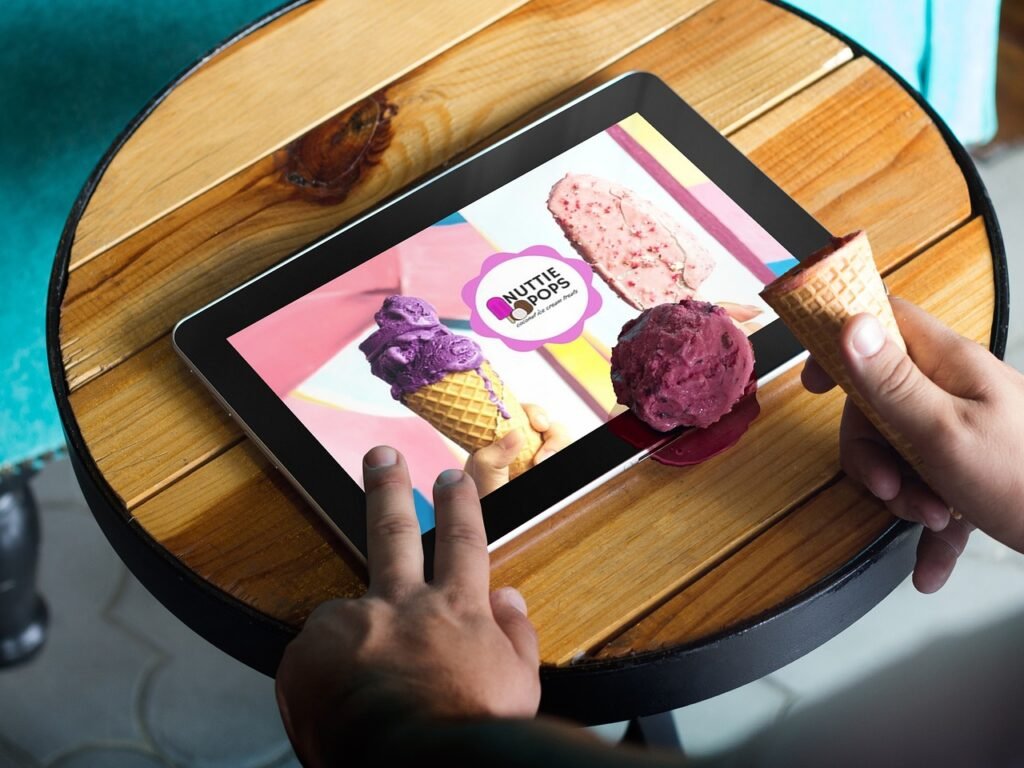This Article has been revised, edited and added to, by Poulomi Chakraborty.
- The Transformation of Branding: Traditional vs. Social Media
- Mastering the Digital Dialogue: Effective Communication Strategies on Social Media
- Harnessing New Technologies and Trends: Keeping Social Media Conversations Fresh
- Brands Excelling in Social Media Adaptation
- Tailoring Social Media Strategies Across Different Industries
- Exploring Key Aspects of Digital Branding Strategies
- Conclusion: Embracing the Digital Dance
Welcome to the whirlwind world of branding in the digital age! Social media isn’t just a part of our daily lives; it’s reshaping the way brands communicate with consumers. Long gone are the days when a catchy jingle and a billboard were enough. Today, the brand conversation is vibrant, ongoing, and ever-evolving, right on your screen. So, how does a brand not only survive but thrive in this bustling digital arena? Let’s dive into the new norms of branding in the age of social media.
The Transformation of Branding: Traditional vs. Social Media

Branding has always been about connecting with your audience, but the way this connection is made has transformed dramatically with the advent of social media. Let’s compare the traditional approaches to the dynamic, interactive strategies now employed on platforms like Twitter, Instagram, and Facebook.
The One-Way Street: Traditional Branding
Traditionally, branding was a monologue. Companies crafted their image and pushed it out via TV ads, print media, and billboards. The message was clear and controlled, but it was also one-way.
Consumers received the information, but they had little room to interact or voice their opinions. Brand perception was shaped by what the company said about itself, and the consumer’s role was largely passive.
The Busy Intersections: Branding on Social Media
Enter social media, and the monologue has turned into a dialogue. Social media platforms are like busy intersections where consumers not only receive brand messages but also respond, question, and converse about them.
Here, branding is no longer about broadcasting a fixed image. It’s about creating a living, breathing persona that interacts with consumers in real-time.
Engagement Over Broadcast
The key difference in social media branding is engagement. Brands can no longer afford to just talk; they need to listen and respond. A consumer might tweet a question or concern, and how a brand responds can significantly affect its image. This real-time interaction adds a layer of authenticity and transparency that traditional branding strategies often lacked.
User-Generated Content and Co-Creation
Another unique aspect of branding on social media is the rise of user-generated content. Consumers today love to be part of the story. They don’t just wear your brand; they share it, review it, and sometimes even co-create it.
Social media platforms have enabled brands to collaborate with consumers, turning them into brand ambassadors. Whether it’s a photo tagged on Instagram or a testimonial on Facebook, each piece of user content adds a layer of credibility and real-world proof that traditional ads can’t match.
Virality and Community Building
Social media branding also capitalizes on the network effect. Content doesn’t just reach viewers; it can be shared, liked, and commented on, multiplying its reach exponentially. This potential for virality is something traditional branding methods could hardly achieve.
Moreover, successful social media brands don’t just create customers; they build communities. These platforms allow brands to gather people with common interests, fostering a sense of belonging and loyalty that goes beyond the product itself.
Adapt or Fall Behind
The shift from traditional branding to social media branding isn’t just optional; it’s essential. In today’s digital-first world, brands that fail to adapt to the conversational, interactive nature of social media risk falling behind. It’s not just about being present on these platforms but being actively engaged, responsive, and adaptable to the shifting digital landscape.

As the founder of a successful e-commerce platform, CleanItSupply.com, I’ve leveraged multiple strategies to digitalize and uplift our brand. One tactic that’s offered substantial rewards is an investment in video production.
Known as ‘Danny D’, I’ve produced over 6,000 product videos that have not only educated our customers but also added a unique personal touch to our branding efforts.
Another effective strategy we implemented is the integration of customer feedback into our branding narrative. We’ve sourced reviews and testimonials directly from our user base, strengthening our brand’s credibility and authenticity.
As for tracking the results, both these strategies showed a significant uptick in our website traffic, better customer engagement, and an overall increase in sales.
Lastly, focusing on Search Engine Optimization (SEO) particularly in our industry of janitorial supplies, has helped us enjoy consistently high rankings in relevant search results.
This put us directly in front of our target market, improved our brand visibility and lead to a clear-cut increase in sales and repeat customers. The results of this strategy were easy to track via online SEO tracking tools, Google Analytics, and overall sales trends.
Dan Dillon, CEO of CleanItSupply.com
Mastering the Digital Dialogue: Effective Communication Strategies on Social Media
Building on the transformation from traditional branding methods to the dynamic interactivity of social media, let’s explore how brands can effectively initiate and maintain digital conversations with their audience. This isn’t just about posting content; it’s about creating a meaningful exchange that enhances brand loyalty and presence.
Understanding Your Audience
The first step in mastering digital dialogue is understanding who you’re talking to. Social media analytics tools provide a wealth of information about your followers—from demographics to behavior patterns. Brands must leverage this data to tailor their messages, ensuring they resonate with the audience. Knowing what content performs well, what times your audience is most active, and even the type of humor they appreciate can make your communication more effective.
Crafting a Brand Voice
Once you know who your audience is, the next step is to define how you want to speak to them. A consistent, authentic brand voice is crucial on social media. This voice should reflect your brand’s personality—whether it’s professional, playful, or passionate. It should be recognizable across all posts and interactions, helping to solidify your brand’s identity in the minds of consumers.
Consistency is Key
Maintaining consistency in your brand voice helps build trust. When your audience sees and hears the same tone and style across all channels, they feel more secure in what your brand represents. This doesn’t mean every post has to sound the same, but the underlying personality should be consistent.
Authenticity Matters
In the age of digital media, consumers are looking for authenticity. They can spot a forced or salesy tone from a mile away. Your brand voice should be genuine, reflecting true values and mission of your company. When a brand is authentic, it builds deeper connections with its audience, which are more likely to convert into lasting relationships.
Engaging Proactively
Engagement is the heartbeat of social media branding. It’s not enough to respond when spoken to; brands need to reach out, initiate conversations, and keep the dialogue flowing.
Ask Questions
One effective tactic is to ask questions. This can be as simple as asking for feedback on a new product or what content they would like to see more of. Questions invite interaction and make your audience feel valued.
Run Contests and Giveaways
Contests and giveaways are another great way to engage. They encourage participation and can help increase your reach and visibility. Plus, they add an element of fun to your brand’s interaction with its audience.
Use Interactive Content
Interactive content such as polls, quizzes, and interactive videos also boost engagement. They provide a fun way for your audience to interact with your brand and can provide valuable insights into your audience’s preferences and opinions.
Leveraging User Content
As mentioned earlier, user-generated content (UGC) is a powerful tool in the social media branding arsenal. Encouraging your followers to share their own experiences with your brand not only provides you with authentic marketing material but also deepens their engagement and loyalty.
Feature User Stories
Sharing user stories or testimonials makes your brand more relatable and trustworthy. It shows that you value your customers and their experiences, which can encourage more users to share their own stories.
Monitoring and Adapting
Finally, effective communication on social media requires ongoing monitoring and adaptation. Social media trends can change rapidly, and what worked last month might not work today. Brands need to be agile, ready to adapt their strategies based on real-time feedback and shifts in the digital landscape.
This active and adaptive approach not only keeps your brand relevant but also demonstrates a commitment to meeting your audience’s evolving needs.

As the Co-founder and Creative Director of Amarra, a high-end formal evening wear brand, I’ve concerted my efforts to amplify our digital presence. They say ‘A brand is a voice and a product is a souvenir’, and we have aimed to echo that sentiment through our digital journey.
One strategy that worked for us was harnessing the power of storytelling, making it ubiquitous across our social media platforms and website. We craft narratives around the creation of our clothing pieces, tying in the artisans’ stories and the inspiration behind each design.
This has not only added a personal touch but has significantly improved our brand engagement. Another tactic was investing in data-driven digital marketing. We use analytics to understand our customers’ behaviour, preferences, and predict trends.
For tracking, we follow metrics like social media engagement, website traffic, and conversion rates. A refined understanding of one’s audience plays a crucial role in devising an impactful branding strategy.
Finally, we concentrated on building a consistent brand image across all platforms, ensuring our customers have a similar experience whether they visit our e-commerce site or our Instagram page.
This consistency has reinforced our brand identity and has solidified Amarra’s spot in the international fashion market.
Abhi Madan, Co-Founder & Creative Director of Amarra

Related: Check out our free SEO suite

Harnessing New Technologies and Trends: Keeping Social Media Conversations Fresh
In the fast-paced world of social media, staying ahead involves not just adapting to changes but also embracing new technologies and trends. Let’s explore how brands can leverage these to keep conversations fresh, engaging, and effective.
Embracing Emerging Platforms
The digital landscape is continually evolving, with new platforms emerging that can reach different segments of your audience. Staying informed about these new spaces and evaluating their potential for your brand is crucial.
Experiment with New Channels
For instance, while Facebook and Instagram are staples, newer platforms like TikTok or even niche forums like Discord offer unique opportunities for engagement. Each platform has its own culture and content style, and tapping into these can help you reach younger audiences or more targeted communities.
Tailored Content for Each Platform
It’s also important to tailor your content to fit the norms and expectations of each platform. What works on Instagram might not work on Twitter, and vice versa. Creating platform-specific content can maximize engagement and relevance.
Leveraging Augmented Reality (AR) and Virtual Reality (VR)

AR and VR are transforming the way brands interact with consumers on social media. These technologies offer immersive experiences that can significantly enhance brand engagement.
AR Filters and Effects
Brands can create AR filters and effects on platforms like Instagram and Snapchat. These not only enhance the fun and interactive element of your content but also encourage users to share these experiences with their network, increasing your brand’s reach.
Virtual Events and Tours
With VR, brands can host virtual events or product tours, which can be especially powerful in industries like real estate, travel, and retail. These experiences allow consumers to engage deeply with the brand from the comfort of their homes.
Utilizing AI and Machine Learning
Artificial Intelligence (AI) and machine learning can play a pivotal role in personalizing the social media experience for users, making brand interactions more relevant and engaging.
Chatbots for Instant Communication
AI-powered chatbots can provide instant responses to customer inquiries on social media, improving customer service and engagement. They can handle a range of requests, from answering product questions to providing recommendations, ensuring that your brand is accessible 24/7.
Personalized Content Recommendations
Machine learning algorithms can analyze user behavior and preferences to tailor content recommendations, ensuring that your audience sees more of what interests them. This not only improves user experience but also boosts engagement rates.
Keeping Up with Social Media Trends
Social media trends can often dictate the effectiveness of your digital strategy. Being attuned to these trends is vital.
Trend Monitoring
Regularly monitoring trends can provide insights into what content is likely to perform well. This could be anything from a viral dance challenge on TikTok to a popular meme format on Twitter.
Participating in Conversations
Engaging with current events and trends can make your brand feel more relatable and timely. However, it’s important to choose trends that align with your brand values and message to avoid seeming out of place or opportunistic.
Consistent Innovation
Finally, the key to keeping conversations fresh is consistent innovation. This doesn’t mean reinventing your strategy every week but rather being open to testing new ideas, measuring their performance, and refining your approach based on what works.
This commitment to innovation should be an integral part of your social media strategy, helping your brand stay relevant and engaged with its audience.

Branded content marketing is effective because it allows brands to connect with their audience on a deeper level. By creating content that resonates with their interests, needs, or values, brands can establish themselves as thought leaders and trusted resources. This approach fosters long-term relationships with customers and can lead to higher engagement and loyalty. It can also drive organic traffic, increase social shares, and improve SEO performance. When done right, it seamlessly integrates the brand’s message into the content without coming across as overly promotional.
Improving Branded Content Marketing
• Audience Insight: Understand your target audience’s preferences, pain points, and interests to create relevant, valuable content.
• Storytelling: Leverage storytelling to make your content more engaging and memorable, while subtly integrating your brand’s message.
• Visuals and Multimedia: Incorporate high-quality visuals, videos, and interactive elements to enhance your content’s appeal and shareability.
• Cross-Promotion: Partner with influencers or complementary brands to expand your reach and increase the credibility of your content.
Hamna Amjad, Project Manager of DMR agency
Brands Excelling in Social Media Adaptation
To illustrate the power of effective social media strategies, let’s delve into some compelling case studies. These examples showcase brands that have not only adapted to the changing landscape of digital branding but have also set benchmarks for innovation and engagement.
Nike’s Digital Community Building

Nike has consistently harnessed the power of social media to strengthen its brand presence and connect with its audience on a deeper level.
Leveraging Influencer Partnerships
Nike’s collaboration with high-profile athletes and influencers has amplified its reach and influence. By aligning with figures who embody the brand’s values, Nike has been able to craft authentic narratives that resonate with their audience.
Community Engagement Through Challenges
A standout initiative has been the Nike Run Club app, which integrates social features to engage its community. Challenges within the app encourage user participation and sharing, creating a sense of community and a shared brand experience.
Glossier’s User-Centric Approach
Glossier, a beauty brand born from a blog, has mastered the art of using social media to turn customers into advocates.
Building a Brand from User Feedback
Glossier’s strategy focuses heavily on user-generated content and customer feedback. The brand frequently engages with its customers on social media, asking for their opinions on products, which not only enhances customer loyalty but also informs product development.
Instagram as a Visual Testimonial Page
Glossier’s Instagram acts as a vibrant testimonial page, filled with user-generated photos, stories, and reviews. This not only demonstrates the effectiveness of their products but also amplifies the voices of their customer base, making users feel valued and heard.
Starbucks’ Seasonal Campaign Success

Starbucks is another excellent example of a brand that uses social media to enhance its seasonal campaigns, particularly with the Pumpkin Spice Latte.
Seasonal and Festive Campaigns
Every fall, Starbucks revitalizes its Pumpkin Spice Latte (#PSL) campaign, creatively using social media to announce the return of the beloved drink. The campaign typically features interactive content, such as Snapchat filters and Instagram stories, to generate buzz and excitement.
Encouraging Participation
Starbucks encourages customers to share their own #PSL moments, which helps the campaign gain traction and reach. By turning their product release into a seasonal event, Starbucks creates anticipation and community participation.
Airbnb’s Experiential Storytelling
Airbnb uses social media to transform the concept of travel and accommodation into one of unique, unforgettable experiences.
Showcasing Real Stories
Airbnb’s marketing focuses on the experiences of its hosts and guests, showcasing real stories and testimonials on its social platforms. This approach not only illustrates the diversity of available experiences but also builds trust and authenticity.
Leveraging High-Quality Visuals
Airbnb utilizes high-quality visuals and videos to capture the essence of staying in unique homes around the world. Their content strategy focuses on the beauty and uniqueness of the locations, appealing directly to the wanderlust of their audience.
These case studies demonstrate how brands can successfully adapt their social media strategies to remain relevant and engaging in a rapidly changing digital landscape. Each brand has found unique ways to leverage technologies, embrace community building, and maintain a fresh conversation with their audience.

As the founder of F&J Outdoor, a startup specializing in outdoor furniture covers, I’ve found a few key digital branding strategies that have really moved the needle for us:
1. Invest in high-quality product photography: Showcasing our covers with attractive, professional images has been essential in conveying the quality and value of our products. Great visuals are vital for grabbing attention and building trust with potential customers online.
2. Leverage user-generated content: Encouraging satisfied customers to share photos and reviews of our covers in use has provided powerful social proof. We share this content across our social channels and website, which has boosted engagement and conversions. A UGC campaign on Instagram grew our following by 25% in just 2 months.
3. Prioritize SEO: Since furniture covers are a niche product, ranking for relevant long-tail keywords has been a major focus. Optimizing our site content, earning quality backlinks, and maintaining an active blog has helped us consistently rank on the first page for target terms, driving steady organic traffic growth.
4. Partner with influencers: Collaborating with home and garden bloggers and Instagram influencers has exposed our brand to relevant new audiences. We provide product for them to review and gift to their followers, driving a 200% spike in referral traffic with each partnership.
These digital strategies, executed consistently over time, have transformed F&J Outdoor from an unknown startup to a recognized leader in the outdoor living space. The key has been staying authentic to our brand while continuing to test, iterate, and closely track the results of each initiative.
Wendy Wang, founder of F&J Outdoor
Tailoring Social Media Strategies Across Different Industries
Each industry has unique characteristics and customer expectations, necessitating customized approaches to social media branding. Let’s explore how businesses in various sectors can adapt and thrive by employing targeted social media strategies.
1. Healthcare: Building Trust and Providing Value
In the healthcare industry, trust and credibility are paramount. Social media strategies here should focus on educating the audience and providing reliable information.
Educational Content
Healthcare providers can use platforms like YouTube or Instagram to share educational videos and infographics that explain complex health topics in understandable terms. This helps in building authority and trust.
Patient Engagement
Engaging with patients through Q&A sessions on Facebook Live or Twitter can also demystify medical queries and make healthcare more accessible. Responding promptly to inquiries on social platforms can further enhance trust and patient loyalty.
2. Financial Services: Enhancing Transparency and Support
The financial sector can sometimes seem intimidating to the average person. Social media can be used to break down barriers and enhance customer support.
Demystifying Finance
Banks and financial institutions can use social media to post tips, financial advice, and explanatory videos that help demystify financial products and services. Instagram stories or Facebook posts on budgeting, investing, or securing loans can be extremely beneficial.
Real-time Customer Service
Using Twitter for real-time customer service is a common and effective strategy in this sector. Responding quickly to customer queries and concerns not only solves problems but also boosts customer satisfaction and loyalty.
3. Education: Engaging and Interactive Learning
For educational institutions, social media can transform traditional marketing and student engagement.
Virtual Tours and Student Showcases
Schools and universities can use social media to offer virtual tours of their campuses, showcase student work, and highlight faculty expertise. Platforms like Snapchat or TikTok can be used to create engaging and fun content that resonates with a younger audience.
Alumni Engagement
LinkedIn is an excellent platform for maintaining connections with alumni. Sharing success stories and updates about the institution can keep alumni engaged and encourage them to contribute to their alma mater.
4. Retail: Creating Immersive Shopping Experiences
Retail businesses can greatly benefit from the interactive and visual nature of social media to enhance the shopping experience.
Live Product Demonstrations
Using Facebook Live or Instagram Live for product launches and demonstrations can create excitement and engagement. Retailers can also use these platforms to offer exclusive deals or behind-the-scenes looks at how products are made.
User-Generated Content and Reviews
Encouraging customers to post pictures and reviews of products can create a rich source of content that enhances credibility and attracts new customers. Instagram and Pinterest are particularly effective for these strategies due to their visual focus.
5. Hospitality: Personalizing Guest Experiences
In the hospitality industry, personalization and customer experience are key.
Showcasing Destinations
Hotels and resorts can use Instagram and Facebook to showcase beautiful images and videos of their destinations, highlighting amenities and unique experiences.
Engaging with Travel Influencers
Collaborating with travel influencers can expand reach and authenticity. Sharing their experiences can resonate well with potential customers, giving them a genuine look at what to expect.
Adaptation Is Key
The key takeaway across all industries is that social media strategies should be flexible and adaptable. What works for one may not work for another, and staying attuned to industry-specific trends and customer behaviors is crucial. Each industry can leverage social media to highlight its strengths and directly engage with its audience, creating tailored experiences that resonate and drive loyalty.

A brand’s content marketing campaign delivers valuable information and educates audiences, compared with traditional display advertising. It is more memorable to 43% of millennials than any other form of advertising.
However, creating authentic, relevant, and valuable content that resonates with the target audience is crucial to achieving the best results. It involves understanding their interests, pain points, and preferences and tailoring content accordingly. Also, incorporating interactive elements such as quizzes or videos can enhance engagement and increase conversions.
By focusing on audience needs and delivering high-quality, engaging content, brands can leverage branded content marketing to build lasting relationships and achieve their marketing goals.
Rene Ymzon, the Marketing Manager at ADVANCED Motion Controls
Exploring Key Aspects of Digital Branding Strategies
Digital branding extends beyond social media, encompassing a range of strategies to establish a strong, cohesive brand identity online. Let’s explore some critical aspects that can amplify your digital branding efforts across various platforms.
Website as the Foundation of Digital Branding
The website is often the first point of contact between your brand and potential customers. It serves as the cornerstone of your digital presence.
Consistent Brand Messaging
Ensure that your website communicates your brand message clearly and consistently. Every element, from the color scheme and typography to the content and imagery, should reflect your brand identity.
Optimizing User Experience
A user-friendly website is crucial. It should be easy to navigate, fast-loading, and mobile-optimized to ensure a seamless experience across all devices. This enhances user engagement and helps reduce bounce rates.
Content Marketing: Building Authority and Engagement
Content marketing is a powerful tool in digital branding. It involves creating and distributing valuable, relevant, and consistent content to attract and retain a clearly-defined audience.
Blogging
A regularly updated blog can help establish your brand as an authority in your field. It also improves SEO, driving organic traffic to your site.
Video Content
Videos are highly engaging and can convey your brand’s story more effectively than text alone. Platforms like YouTube, Vimeo, and social media channels are excellent for video marketing.
SEO and SEM: Enhancing Visibility
Search Engine Optimization (SEO) and Search Engine Marketing (SEM) are critical for increasing online visibility and attracting more traffic to your website.
Keyword Strategy
Implementing a strong keyword strategy can improve your rankings in search engine results pages (SERPs), making it easier for potential customers to find you.
Pay-Per-Click Advertising
SEM strategies like pay-per-click (PPC) advertising can drive immediate traffic to your site. This is particularly useful for new product launches or promotional campaigns.
Email Marketing: Personalization and Retention
Email marketing remains one of the most effective digital branding strategies, offering direct communication with your audience.
Personalized Campaigns
Using personalized emails tailored to individual preferences and behaviors can significantly increase engagement rates. Tools like segmentation and automation make this more manageable.
Newsletters
Regular newsletters can keep your audience informed about the latest news, products, and content, helping to maintain interest and engagement over time.
Reputation Management: Monitoring and Responding
Online reputation management is crucial for maintaining a positive brand image. It involves monitoring mentions of your brand across the web and responding appropriately to feedback.
Social Listening
Social listening tools can track what’s being said about your brand online, allowing you to respond swiftly to both positive and negative mentions.
Handling Reviews
Actively managing reviews, especially on platforms like Google and Yelp, can improve your brand’s credibility and attract more customers.
Analytics and Adjustments: The Key to Improvement
Finally, the ability to analyze and adapt is what truly powers a successful digital branding strategy.
Data Analysis
Regular analysis of data from your website, social media, and marketing campaigns can provide insights into what’s working and what isn’t, helping you refine your strategies.
A/B Testing
A/B testing different aspects of your digital marketing—from email campaigns to landing pages—can optimize performance and improve user engagement.
By integrating these diverse aspects into a cohesive digital branding strategy, businesses can enhance their online presence, build stronger relationships with their audience, and drive growth. Would you like to focus on any specific digital marketing technique or tool for deeper exploration?

So for those wondering how to promote their fitness startups by leveraging digital channels, I’ve compiled a few digital marketing tips for gym owners / founders / marketers:
1. Your CRM is key. You need a multi-functional CRM. You need to be able to track leads, conversions, sign ups, and so many other metrics relevant to the fitness industry. I’d recommend a CRM that also incorporates email marketing and campaigns as that will help with an in-depth overview of your marketing data.
2. Whilst performance marketing is an essential part of the digital marketing mix when it comes to quick traction and lead generation, it’s crucial to understand the sales cycle and ROAS when running performance marketing campaigns. This will enable your marketing team to make validated marketing decisions when it comes to budget spend.
3. Social media can be (and usually is when done well) a key revenue driver. In some cases, it might even be your primary revenue driver. Understand how it fits into the TOFU (top of the funnel) marketing in terms of customer acquisition.
4. SEO is heavily underrated for gyms. Yet can yield great results especially for niche studios or specific classes offering. Give it at least six months for your content to rank – don’t rush the results.
Marianna Boguslavsky, Founder and Digital Strategist at Boguslavsky & Co
Conclusion: Embracing the Digital Dance
In the digital age, branding is no longer just about presenting a polished image; it’s about creating a dynamic and interactive conversation with your audience across multiple platforms. From the foundational role of a well-designed website to the engaging powers of content marketing, and from the visibility boosts afforded by SEO and SEM to the personal touches enabled by email marketing, every element contributes to a robust digital brand identity. Additionally, vigilant reputation management and the insightful use of analytics ensure that your brand remains responsive and relevant in a rapidly evolving marketplace.
The key to successful digital branding lies in understanding that it is a continuous dialogue with your audience—rooted in authenticity, fueled by strategic content, and refined through ongoing feedback and adaptation. Brands that master these elements are not just seen; they are experienced and followed. This holistic approach ensures not just visibility but a lasting resonance with consumers, paving the way for enduring loyalty and growth.
Read next
- Pinterest SEO for Travel Blogs and Businesses
- Social Media Signals and SEO for Travel Websites
- How to Use Analytics to Understand Travel Seasonality
- Analyzing User Behavior and its SEO Implications
- Using Funnel Analysis for Better Conversion Rates






















Comments are closed.